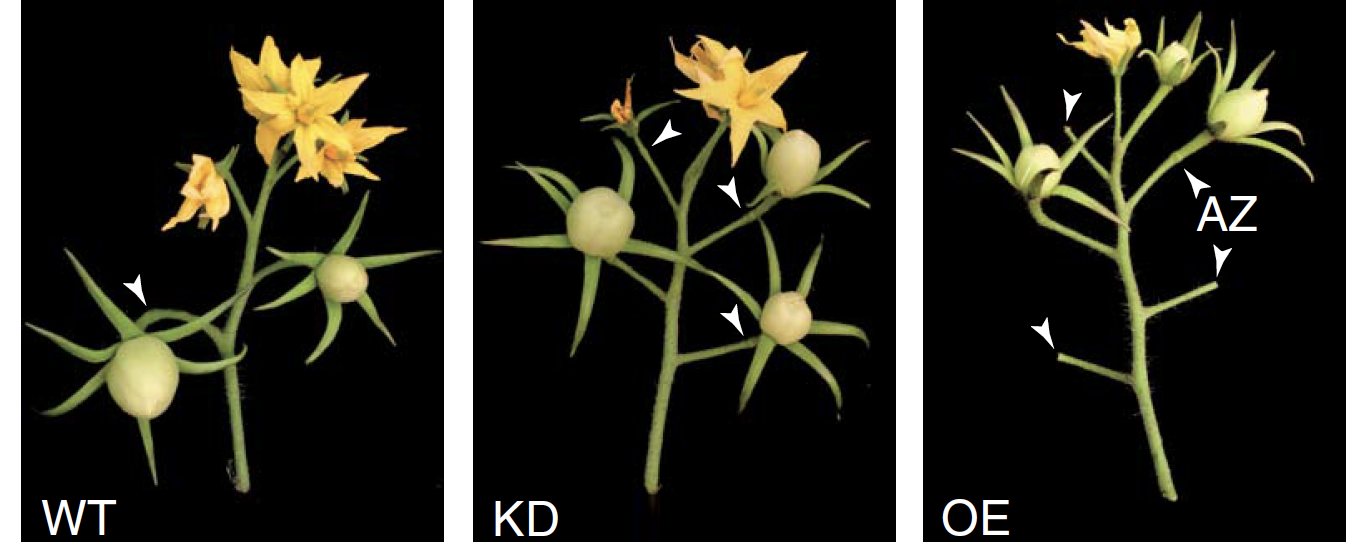博文
Science:磺肽素作用于番茄中由干旱诱导的花凋落
||
Peptide signaling for drought-induced tomato flower drop
First author: S. Reichardt; Affiliations: University of Hohenheim (霍恩海姆大学): Stuttgart, Germany
Corresponding author: A. Schaller
The premature abscission of flowers and fruits limits crop yield under environmental stress. Drought-induced flower drop in tomato plants was found to be regulated by phytosulfokine (PSK), a peptide hormone previously known for its growth-promoting and immune-modulating activities. PSK formation in response to drought stress depends on phytaspase 2, a subtilisin-like protease of the phytaspase subtype that generates the peptide hormone by aspartate-specific processing of the PSK precursor in the tomato flower pedicel. The mature peptide acts in the abscission zone where it induces expression of cell wall hydrolases that execute the abscission process. Our results provide insight into the molecular control of abscission as regulated by proteolytic processing to generate a small plant peptide hormone.
胁迫环境下花和果实的提前脱落严重限制了作物的产量。西红柿中干旱诱导的花凋落是由磺肽素(phytosulfokine,PSK)调控的,PSK是一个多肽激素,先前的研究显示其作用于促进植物生长和促进植物免疫。响应于干旱胁迫,植物形成PSK主要依赖于植酸酶亚类中一个类枯草杆菌蛋白酶,即植酸酶2(植酸即肌醇六磷酸),其在番茄花梗中通过对PSK前体的天冬氨酸特异性加工形成多肽激素PSK。成熟的多肽在离层区域发挥功能,其诱导细胞壁水解酶的表达,从而加速器官脱落。本文的研究结果揭示了植物中一个小肽激素作用于离层,促进器官脱落的分子机制。
Background
在植物中,花、叶片或者是果实的凋落是营养、生殖生长发育都必不可少的生物学进程。而在有限的营养条件或者是处于胁迫的环境条件下,很多植物中都会出现提前凋落花组织的现象。而由于全球变暖,由干旱或高温诱导的花早谢可能会越来越呈恶化事态。之前,关于器官脱落的研究主要集中在番茄和拟南芥的花组织。番茄中,花的凋谢主要发生于果茎上的离层区,该过程主要受到植物激素的控制。在正常的花和果实发育过程中,有顶向基的生长素转运会保证离层区持续的生长素供应,从而使得离层区保持在非活跃状态,防止花或果实脱落。而当花发育成熟时,生长素的流量减小,果茎离层区对乙烯信号变得敏感,此时需要乙烯信号来诱导花器官凋落。拟南芥中的研究显示,乙烯不敏感突变体中萼片、花瓣和雄蕊的脱落被延迟,但最终仍会脱落,说明乙烯控制的是器官脱落的时间,而非是否脱落。拟南芥中,花组织的凋落取决于一个由类枯草杆菌蛋白酶丝氨酸蛋白酶从IDA(INFLORESCENCE DEFICIENT IN ABSCISSION,一种参与花器官脱落的多肽)蛋白中释放的小肽。成熟的IDA多肽会激活一个受体复合物,该复合物包含受体激酶HASEA(或其旁系同源蛋白HAESA-like 2)与SERK共受体,从而诱导一个丝裂原活化蛋白激酶(mitogen-activated protein kinase,MAPK)级联,以调控作用于细胞壁中间果胶层破坏及细胞分离的细胞壁水解和修饰因子的表达。另外,IDA还控制拟南芥中茎生叶(cauline leaves)的凋落。相反,番茄中有关花或果实在胁迫条件下过早脱落的分子机制还不清楚。
Results
1. 筛选番茄中的候选subtilas

Fig. 1. Flower drop is enhanced under drought stress in a SlPhyt2-dependent manner. (A) Inflorescence phenotype of SlPhyt2-silenced (knockdown, KD) and overexpressing plants (OE) compared to wild type (WT). OE plants abscise flowers prematurely at the pedicel abscission zone (AZ, arrowhead).
作者为了研究番茄中是否存在类似于拟南芥中的花凋落机制,构建了各种subtilases的过表达转基因株系,结果发现过表达(Overexpress,OE)phytaspase 2(SlPhyt2)的番茄转基因植株存在花器官的过早凋落表型(Fig. 1A、B)。
Fig. 1 (B and C) Flower drop was analyzed in KD (blue), OE (magenta), and WT (gray) plants under well-watered (B) and drought conditions (C).
当暴露在干旱条件下时,作者发现OE植株相比于WT花凋落得更多(Fig. 1C),而SlPhyt2的敲低(knockdown,KD)突变体相对花提早凋落更少(Fig. 1C),所以相比于WT和OE座果率更高(Fig. S4)。
2. 验证SlPhyt2表达模式
Fig. 2. SlPhyt2 expression is induced by drought stress. (A) SlPhyt2 expression is induced in leaves of drought-stressed (color-shaded bars) WT plants (gray) and overexpressing plants (magenta) but not in knockdown plants (blue) (B) Phytaspase activity in cell wall extracts of leaves from droughtstressed plants is reduced in knockdown and increased in overexpressing plants as compared to wild type. (C) Histochemical staining of SlPhyt2pro::GUS activity in the proximal pedicel of developing tomato flowers. (D) GUS staining in leaves and inflorescences of control and drought-stressed plants.
根据上面的试验,作者有理由推测番茄中干旱诱导的花早谢与SlPhyt2蛋白的表达和活性有关。首先,作者验证了叶片中SlPhyt2基因会受到干旱的诱导而上调表达(Fig. 2A),并且干旱处理下SlPhyt2蛋白活性在OE中升高,而在KD中降低(Fig. 2B)。接着,作者进一步利用SlPhyt2pro::GUS验证了无论是在果茎靠近离层部位或是叶片的维管组织中,SlPhyt2基因的表达均会受到干旱胁迫的诱导(Fig. 2C、D)。
3. SlPhyt2的作用机制探索
Fig. 3. Abscission is regulated by SlPhyt2 and PSK in an auxin- and ethylene-independent manner. (A) Induction of SlPhyt2 expression in the proximal (prox) compared to the distal (dist) pedicel after flower removal analyzed by qPCR before (open bars, control) and 14 hours after flower removal (gray bars) normalized to abscission zone (AZ) control. (B) qPCR analysis of SlPhyt2 expression in abscission zone + 5 mm of the flanking pedicel compared to TAPG4 and phytohormone response markers. (C to E) Pedicel abscission assayed over time for SlPhyt2 knockdown, overexpressing, and WT plants in a detached-flower bioassay. (F and G) Bioassay for abscission in knockdown, overexpressing, and WT inflorescence explants showing the time (day) until >50% of pedicels had abscised.
接着,作者通过切掉花来屏蔽生长素的供应,结果发现SlPhyt2基因在果茎近端区域中被诱导表达(Fig. 3A)。然后,作者研究了SlPhyt2基因的表达是否会受到植物激素生长素或乙烯的影响。通过分析OE和KD中生长素和乙烯信号标记基因的表达量,作者发现这些标记基因在OE和KD之间没有明显差异。而SlPhyt2基因确实是在OE中高表达,而在KD中基本不表达。而且番茄一个离层相关的聚半乳糖醛酸酶编码基因TAPG4也与SlPhyt2显示出一致的表达模式(Fig 3B)。此外,通过施加乙烯拮抗剂1-MCP或者向移除花的植株中重新补充生长素都不能消除OE、KD和WT之间的差异(Fig. 3F、G)。这些试验说明在番茄中,SlPhyt2通过一个独立于生长素和乙烯的通路来作用于离层的形成。
4. SlPhyt2的下游因子(PSK)的鉴定
Fig. 4. Formation of PSK as an abscission signal depends on Asp-specific cleavage of the precursor by SlPhyt2 in vivo. (A) iceLogo showing amino acid residues preferred by SlPhyt2 upstream (positions 1 to 5) and downstream (positions 1′ to 5′) of the cleavage site.
既然,SlPhyt2不通过生长素和乙烯发挥作用,那么作者得进一步鉴定SlPhyt2的下游因子。通过在SlPhyt2的C端添加一个6组氨酸标签(hexa-His tag),作者通过金属螯合亲合层析的方法提取了带标签的subtilase蛋白,然后通过一个蛋白质组试验(Proteomics Identification of Cleavage Sites)检测重组蛋白的底物特异性。结果发现,SlPhyt2特异性剪切位点的氨基酸为天冬氨酸(Asp,D),并且剪切位点的上一个和下一个氨基酸偏好疏水氨基酸(Fig. 4A)。通过筛选可能的下游作用多肽激素,作者发现了SlPhyt2的两个候选底物:一个是系统素(systemin),含18个氨基酸,在番茄中主要作用于创伤响应和对草食动物的防御信号;另外一个是硫酸化的五肽,即磺肽素(PSK)。作者在KD株系中并未观测到明显的创伤信号或草食动物防御缺陷,因此排除系统素,那么剩下的就是PSK了。
5. 试验验证PSK
Fig. 4. (B) C terminus of the eight PSK precursors encoded in the tomato genome; sequence of the PSK peptide highlighted in green. (C and D) Ion chromatograms showing cleavage products generated by SlPhyt2 from N-terminally extended PSK (extPSK) (C) and a phytaspase-resistant D-to-A variant of the same peptide (resPSK) (D). (E) qPCR expression analysis of TAPG and phytohormone response marker genes in abscission zones of PSK-treated (5 mM; green) compared to control inflorescences (gray). (F) Abscission bioassay showing the percentage of pedicel drop on day 3 after flower removal in WT (gray) and knockdown inflorescences (blue) treated with extPSK (ext), resPSK (res) or water (H2O).
番茄中有6个基因编码PSK前体蛋白,并且均具有保守的天冬氨酸D以及上下游的疏水氨基酸(Fig. 4B)。但是,在离层表达的只有SlPSK1/4/6,并且只有SlPSK1/6与SlPhyt2基因具有一致的受干旱胁迫诱导表达模式。作者合成了一个包含硫化五肽(sY)I(sY)TQ和N端EAHLD的PSK前体(extPSK),体外试验显示SlPhyt2能够顺利剪切该合成前体,形成成熟的PSK(Fig. 4C)。而将合成前体中的Asp换成丙氨酸Ala(resPSK),则SlPhyt2不能剪切(Fig. 4D)。通过对WT、OE和KD株系施加外源的PSK,作者发现PSK诱导的器官脱落存在明显的剂量效应(Fig. 3C-D)。另外,PSK处理能够诱导离层标记基因TAPG2和TAPG4的表达,并且降低维持离层非活跃状态相关基因的表达(Fig. 4E)。最后,作者通过对去除花的WT和KD施加H2O、extPSK和resPSK处理,结果发现在WT中,施加extPSK可以明显增加花脱落,而KD中的花脱落比例均保持在一个非常低的水平(Fig. 4F),说明PSK前体中的Asp和SlPhyt2对于番茄中PSK离层信号的生物发生均是必需的。
Conclusion
结合前文的试验,作者得出结论,番茄中的SlPhyt2作为发挥功能的subtilas,响应于外界环境高温胁迫,通过加工PSK前体形成成熟的PSK,作用于花或果实脱落的离层形成。
Discussion
果实成熟时的脱落是由生长素和乙烯信号所控制的。而番茄中,响应于高温胁迫时花的过早脱落是由PSK所控制的。至于PSK如何与生长素、乙烯介导的离层活性调控还有待进一步研究。
PSK先前所报道的功能主要是促进植物生长,本文的研究则将PSK诱导的细胞分离与器官脱落联系起来。离层区细胞的扩大为细胞壁胞间层(middle lamella)水解后的的器官脱落提供了剪切力。因此,PSK可能通过诱导细胞扩张和细胞壁水解酶表达作用于器官脱落。
尽管PSK在单、双子叶植物中广泛存在,但是枯草蛋白酶中SlPhyt2所属亚类的植酸酶并不是广泛分布的。目前的数据显示,其仅存在于双子叶植物中的茄科、毛茛科、豆科、唇形科和葫芦科。所以,PSK介导的离层发育和器官脱落是否广泛存在于开花植物还是一个未解之谜。
通讯:A. Schaller (https://www.uni-hohenheim.de/organisation.html?tx_base_lsfcontentadmin[lsfPerson]=3881#contact)
doi: 10.1126/science.aaz5641
Journal: Science
Published date: March 27, 2020
p.s. PSK相关研究链接:
Plant Cell:植物磺肽素PSK作用于番茄生长素依赖的免疫响应
https://blog.sciencenet.cn/blog-3158122-1228588.html
上一篇:Nature Plants:腋生分生组织成熟抑制因子促进开花植物长寿
下一篇:EMBO Journal:番茄驯化过程中作用于耐盐性丢失的关键基因
全部作者的其他最新博文
- • Plant Physiology:CsMADS3促进柑果中的叶绿素降解和类胡萝卜素合成(华中农业大学)
- • Molecular Plant:LBD11-ROS反馈调节作用于拟南芥的维管形成层增殖和次生生长(浦项科技大学)
- • Science Advances:根结线虫通过调控植物的CLE3-CLV1模块,促进侵染进程(日本熊本大学)
- • Nature Communications:油菜素内酯参与植物营养生长期转变的分子机制解析(浙江农林大学)
- • Current Biology:光合作用产生的蔗糖驱动侧根“生物钟”(德国弗莱堡大学)
- • PNAS:花同源异型基因在叶中被抑制、花中被激活的分子机制(南卡罗来纳大学)